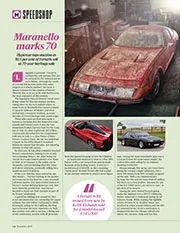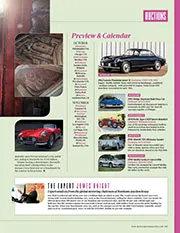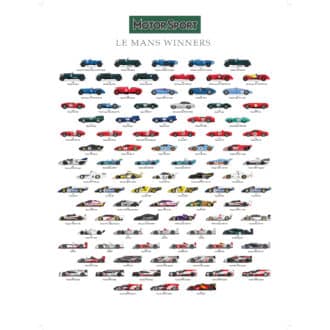

Maranello marks 70
Hypercar tops auction as 92.5 per cent of Ferraris sell ‘Leggenda e passione’. Ferrari is perhaps the only marque that can be excused for the habitual use of such clichés,…
TVR – over and out?
Amid rumours of a new Veyron-baiting supercar and a move from Blackpool to Florida, our man ponders the marque’s future and pays his respects to its past efforts. It’s been a riot…
I know no better than you what, if anything, the future holds for TVR. I’ve read too many stories of last minute salvation to set any store by those that pop up in the press. But I do know that if TVR has indeed had it, I for one will miss the marque terribly.
If it goes, I will never receive another call from someone at TVR responding to a printed suggestion of mine that some of its products might be less than entirely reliable. Among a small but close-knit community of driver-hacks like me, these conversations are fabled. You’d wait for the initial complaint to be lodged, endure the bit where they asked why you never mentioned all the other cars that broke down on you and wait for the moment of truth when you were told without the smallest smirk that TVRs were as reliable as Porsches. For sheer unwavering, don’t-blind-me-with-the-facts resolve, these little chats were unrivalled.
I’m not going to recount all the stories of all the TVRs that have broken on me and my colleagues, partly because there isn’t the space but mainly because I wasn’t joking when I said I’ll lament its passing, if that is what transpires. However much TVRs have annoyed or infuriated me in the past, none has committed the only sin for which there is no forgiveness: in all my years doing this job, I have never once been bored driving a TVR.
In fact many have been rather too exciting. The first one I ever drove in a professional capacity was a V8S which looked like a Taimar into which some bright spark in Blackpool had shovelled a large V8. When I first tried to record its maximum velocity, the car was so unstable above 140mph on the speed bowl I almost packed up and went home there and then, convinced I did not have what it took to earn a living testing cars. It was only when I got back to the office and my more experienced colleagues told me TVR’s chassis engineers still did their high-speed aero work on the M55 that I began to feel a bit better about it all.
What saddens me further about the potential passing of TVR is that unless someone rescues the company and secures its future, when people look back at it and think of the cars it produced, it will be for their often shoddy build quality that they will be predominately remembered. What is likely to be forgotten is that, in the admittedly less than brilliantly constructed mix, there were some fine cars, too.
The greatest ever to pass through my hands was the Griffith of the early 1990s. They made them with at least four different sizes of Rover V8 between four and five litres, but the best by far was the 4.3-litre unit available on early cars before catalytic converters were required. The car was light, handled remarkably well by TVR standards and, of course, looked fabulous. But that engine also made it go like a maniac and sound better than all but a handful of other road cars. At the time the usual issues meant you’d have been sensible to have avoided one like a house with a black cross on the door, but more than 15 years on all the bits that were going to fall off will have done so long ago and been repaired properly. And the major mechanical components, like the Rover motor and Borg-Warner ’box, are incredibly strong, while the glassfibre panels mean the body is immune to rot.
I also hope there is a future to the TVR story, because, from what I could tell, in recent years there appears to have been a serious and credible attempt to build cars that not only look good and go well, but last a long time, too. The last ones I drove all covered decent distances in my hands without a significant mechanical or electrical failure.
They also showed signs of realisation at Blackpool that TVR now needed to make its cars go around corners. With certain honourable exceptions (such as the Griffith), most TVRs I’ve driven have had chassis that lagged far behind the potential of their engines. A few years back I used to spend a few weekends every season doing track days at the old Nürburgring, where TVR-baiting became a favourite sport because every one could be relied upon to roar down the straights and crawl through the corners, an approach never likely to add up to a quick time at the ’Ring. After a year or two, the TVRs stopped coming. But its more recent efforts have been taut, precise and even fairly rewarding on the right road.
Yet what I liked most about TVRs, and what I fear I will miss above all, is their invention and originality. The dials and minor controls may not have always worked brilliantly but they were always fantastic to look at. And if it all went wrong, you could at least sit at the side of the road waiting for the recovery truck, admiring a truly non-conformist motor car. Every time a new one turned up, simply working out how to open the door was a little adventure, and how many other cars can claim that today?
I hear so much about what’s next for TVR – that it will soon be building 5000 cars per year in Florida and that work has already started on a Bugatti Veyron rival. I’m inclined to be sceptical. That number of cars would put TVR at a similar size to Ferrari and quite how they could be produced and sold for a profit is something that boggles the mind. And removed from Blackpool, would they really be TVRs? So if it is really all over, I’d just like to say thanks for the ride: it’s been exciting, occasionally frightening but never dull. If only I could say the same about all the allegedly high-performance cars I drive.



